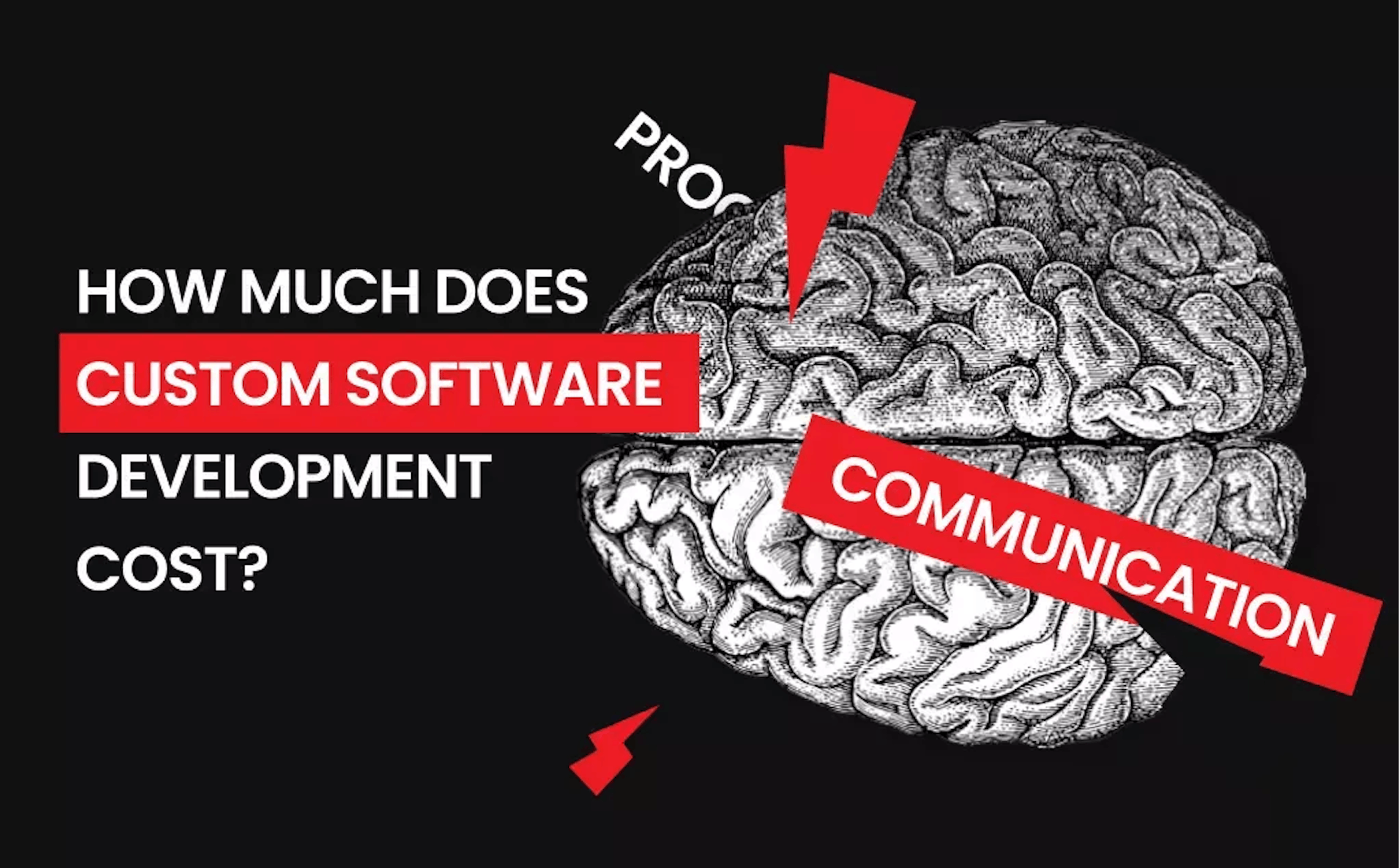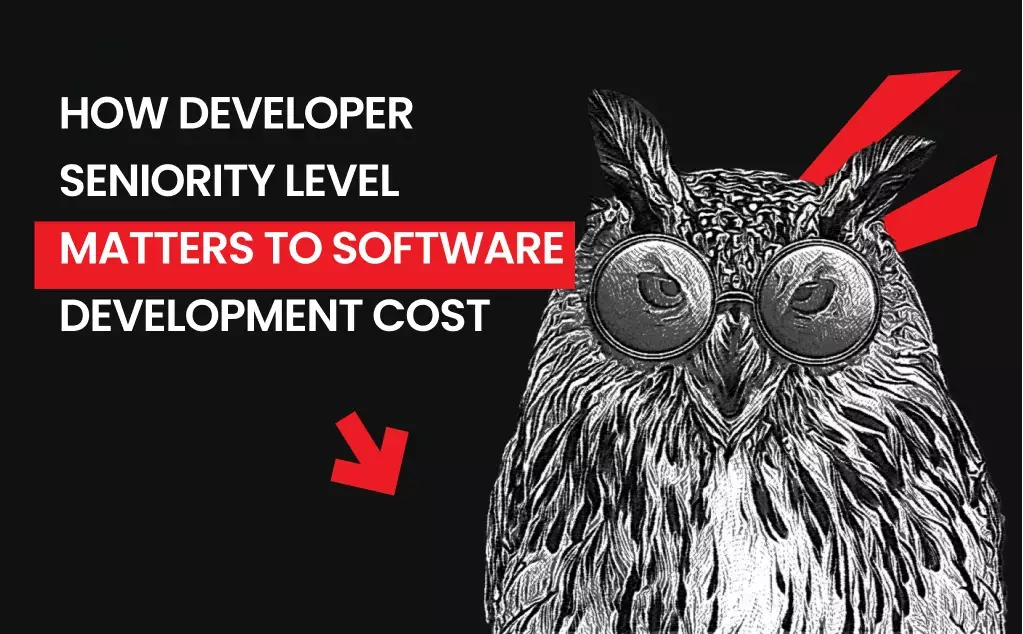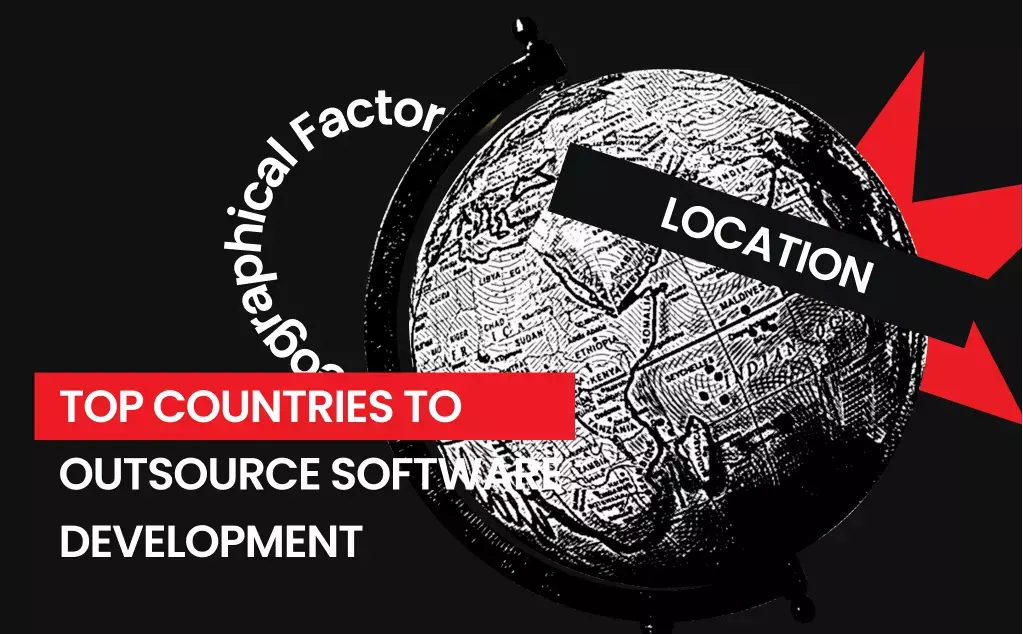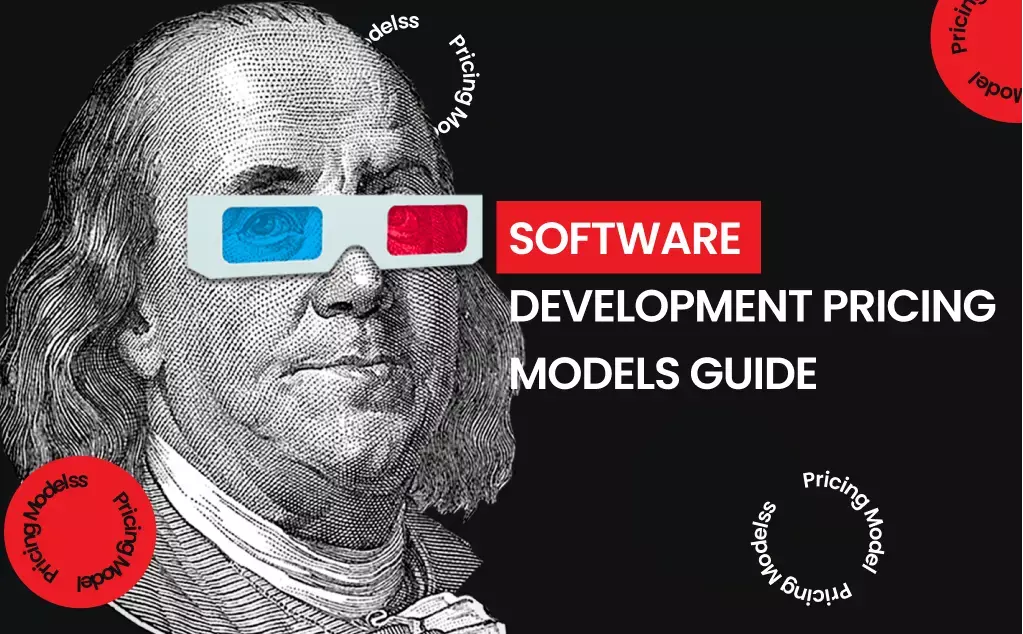Mad Devs Customer University is a series of publications about pricing strategies that aim to help customers choose the right contractor and maximize the benefits of working with them. We will address every aspect of customer-contractor interactions to show how to achieve a profitable partnership.
Quick summary
Custom software development refers to the process of developing applications that meet the specific needs of a specific user group or individual within an organization. This type of software is usually created by a third-party developer and is not bundled for reselling. Custom software development is a preferred approach because it provides the exact features and capabilities that an organization needs.
There is no single number that would accurately capture the cost of developing custom software because a variety of factors affect the final total, from the initial plan and timeline to the specific functionality of the app. Even with a simple project, costs can vary depending on the complexity of the work, the development team's composition, and the team's location. While there are many aspects to consider, this article will break them down in order to provide you with the best estimate possible for your software project.
Factors that shape software pricing
Let's start with a look at the several factors that affect the cost of software development, regardless of the size of the company or the location of the developers:
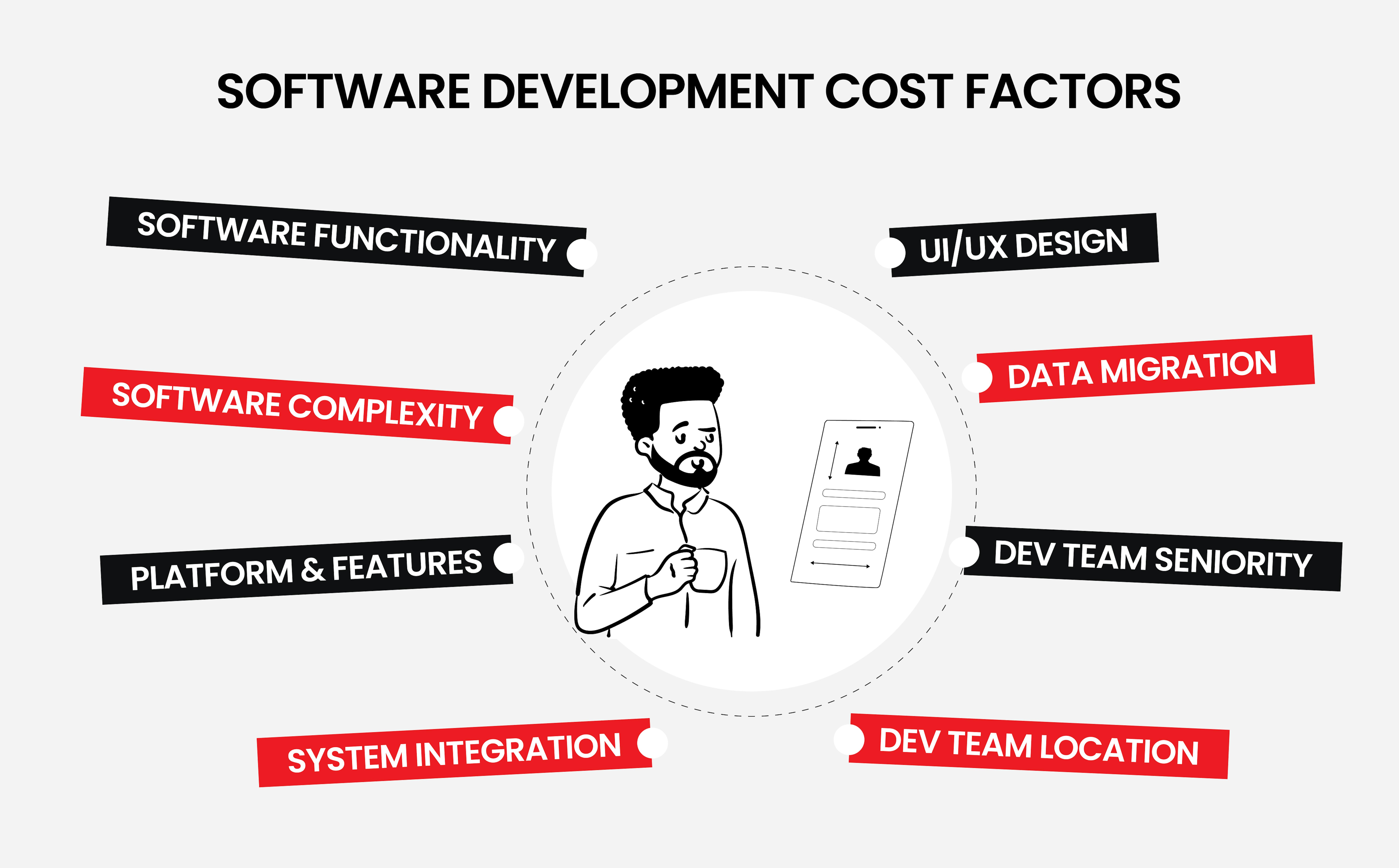
We'll discuss each of these factors in more detail through an example of a company that wants to create an app:
OnTrack is a US-based start-up that wants to create an app that tracks users' finances, provides recommendations on stores and cafes that will keep them within their spending goals without making too many sacrifices, and shows them how much they can save by the end of the month as extra, unspent income.
Here's what the company has planned so far for the app:
- Around 25-40 screens
- Map feature
- Reviews features
- Works on iOS and Android
- Access to a user's financial information
OnTrack wants to create a minimal viable product (MVP) within the shortest timeframe possible. To start the journey of turning their idea into a real app, they begin looking for a software development team. We'll examine the details of this stage and develop an estimate of the costs involved.
Choosing a team
Within this stage, there are different aspects that will affect the final cost of the team OnTrack hires to create their product. They are the size of the team, the seniority of the members, and the hiring and pricing model OnTrack agrees on with the contractor.
Team size
When OnTrack has defined its project, it'll be easier to understand the team size required to develop it. The more complex an app, the larger the team, and vice versa. However, every project includes at least four roles: a software developer, project manager, business analyst, and QA tester.
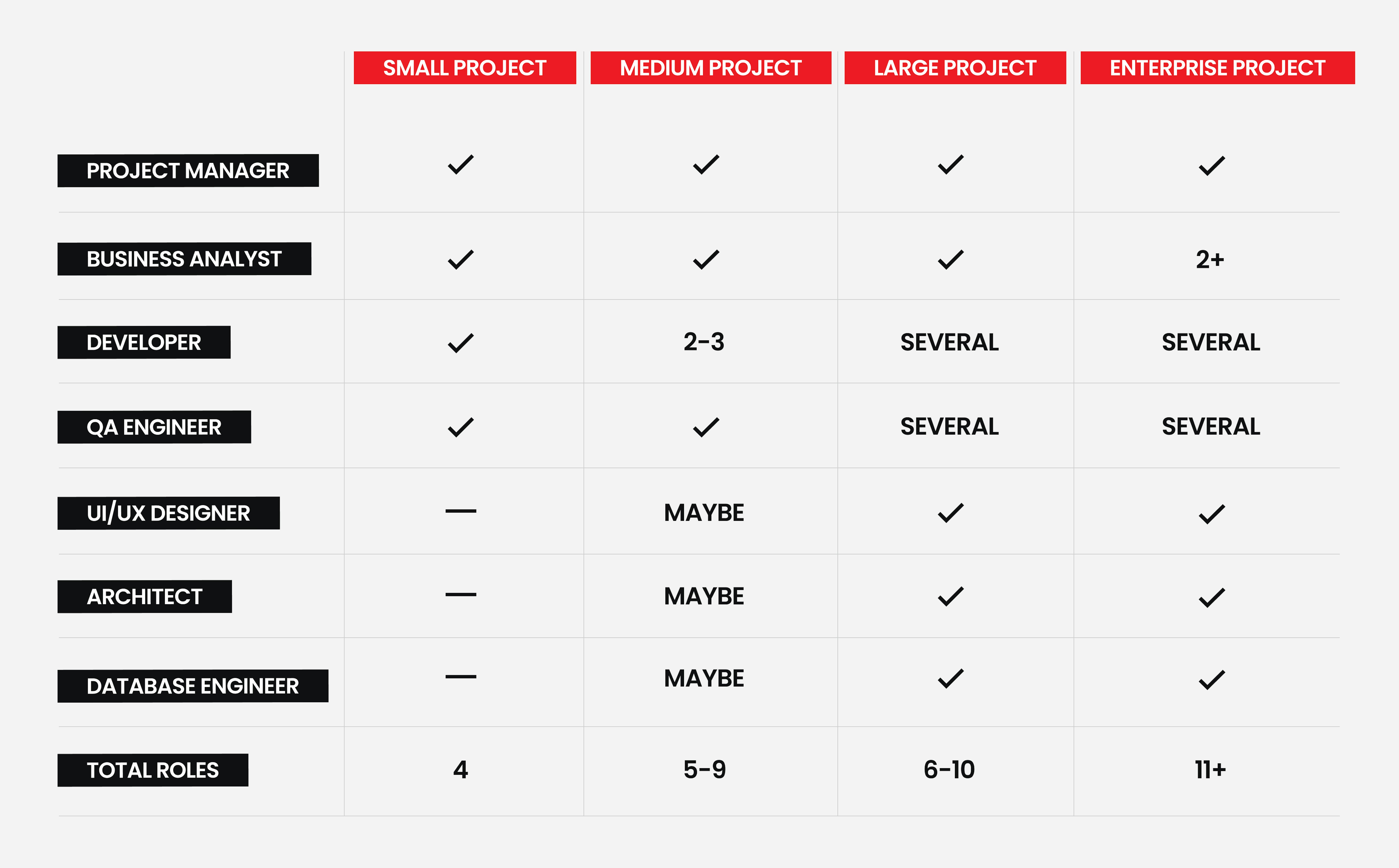
📝 Useful tip
For a small or medium-scale project, the developer may also serve as the tester. The project manager may also oversee the business analyst and other tasks.
Seniority
The team's level of expertise is also highly valued. The hourly rate of a top-level developer can be dramatically different from the rate of an entry-level one. This is an important consideration when hiring teams according to the models we'll discuss later. For those who may not be familiar with developer grading, these are the standard roles you will encounter:
- Junior developer: 0–2 years of experience. Work on smaller tasks, often with supervision and mentorship.
- Mid-level developer: 2–5 years of experience. More autonomous, capable of handling entire features or parts of a project while collaborating closely with senior developers.
- Senior developer: 5+ years of experience. Can work independently on complex tasks and are capable of leading projects or teams.
There are many nuances involved with developer seniority and how it affects the cost of software development. Check out this article for a detailed understanding of the topic.
Location
With an understanding of the role a team's makeup plays in the cost of their software development, OnTrack's leaders will need to decide where to look for their development team. Today, it's possible to hire qualified specialists around the world, even for an in-house hybrid or remote team. Cost of living and market conditions can allow companies like OnTrack to find the best balance of cost and quality for their projects.
Below is a rough estimate of the average hourly rates for software developers in different regions. Even if you agree on a fixed-price model, these prices are helpful for understanding what to expect. Remember that a developer's seniority and technical expertise also affect this cost and that there are variations within regions as well. Finally, OnTrack will need to consider that a lower cost is not always the best approach, especially if their project requires higher levels of expertise.
Average hourly rate of software developers by region
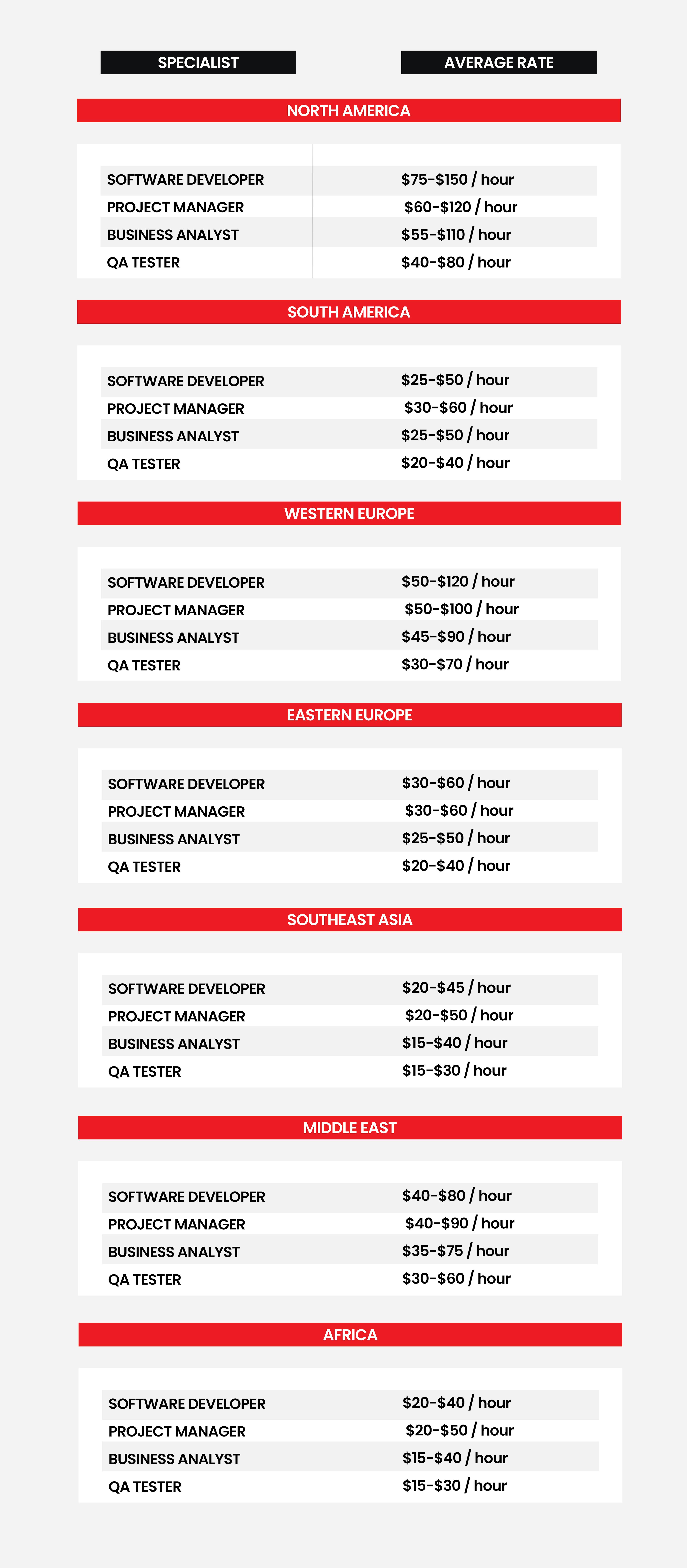
Hiring models
Now that OnTrack's management has an idea of the type of team they want to hire and where the team will be, they will need to decide on the hiring model they want to use. There are multiple hiring and payment options to consider. Here is a comparison of hiring models:

Pricing model
When reviewing teams or freelancers, OnTrack will encounter differing pricing models, such as a fixed price or hourly rate. OnTrack must choose a model that reflects its plan and understanding of what it expects from the finished product. Here's a breakdown of each model and how they affect development.
Fixed price: Includes the cost of potential risks (adding 20% or 300% to their price). This model leaves little room for flexibility or scope management and assumes that the client has detailed requirements. If a fixed price is proposed, make sure the contractor has a convincing description of how they'll handle the tasks: they must be sure they know what they're doing.
Hourly rate: A more flexible option for accommodating new requirements for the app and provides a business with the flexibility to adapt to changes in the market.
Time & material: This model assumes the client is willing to pay for all the time and materials (programs/resources) required to complete the project. While it doesn't guarantee that a project will fall within the initial budget expectations, it does offer more flexibility and agile approaches. This option is preferable in long-term projects because it implies a more or less stable monthly budget and allows adjusting requirements without receiving approvals from the contractor's management.
OnTrack decides their project requires a medium-sized dedicated team with one project manager, a business analyst, three developers, a UI/UX designer, and a QA engineer. This is a total of seven individuals working under a time & material model.
Choosing a contractor: state-by-stage
OnTrack's leaders have chosen the preferred size and composition of the team. Now, they can now begin communicating with potential contractors to find the best deal.
The company will want to make the search process as efficient as possible because it can require time, especially when deadlines are approaching. They should start by narrowing down the list of options to those with experience doing the type of work required for the project.
Stage 1: The search
In OnTrack's situation, they want companies or individuals with experience working with fintech. They gather options and begin communicating with these companies. Here are the points OnTrack will use to make their decision:
- Communication patterns: How contractors communicate during the pre-proposal period is an accurate reflection of how they work in general. Be aware of missed deadlines or unkept promises.
- Portfolio: Make sure the materials and examples in a company's or freelancer's portfolio align with your expectations and requirements.
- Compatibility: Culture and principles are important too. Look at who the company or the person worked for before, how they present themselves, and other factors when making a decision.
Stage 2: Request a proposal
With a list of potential candidates, OnTrack will request an estimate from each. While the contractors are preparing their proposal, they may and should ask OnTrack follow-up questions about the project. The questions are important. Were they relevant and insightful? Did the contractor pay attention and try to gain insight? If you have three "yes," you're on the right track.
Are the questions the contractor asks you strictly technical? Some choose to stay safely within your specifications, while more experienced contractors will critically assess your ideas and suggest doing things in a way that, say, will be more competitive in the current market. So their questions will include those about your target audiences and business goals.
Once OnTrack receives the proposals, it's time to evaluate them. Here are the sections the proposals should contain to provide transparency in the price estimate:
- Executive summary that succinctly addresses the client's problem and solution and explains the benefits of using this company's or individual's services.
- Company profile with background information about the company and relevant case studies or success stories.
- Project understanding that demonstrates a detailed understanding of the client's requirements and challenges, including insights gained from discussions with the client and a summary of the client's goals and objectives.
- Scope of work with an overview of the proposed software solution, technical specifications, features, and functionalities, as well as user interface, user experience, scalability, and performance considerations.
- Project timeline that provides an estimated project timeline with key milestones and a breakdown of phases (e.g., planning, design, development, testing, deployment).
- Development methodology to explain the company's approach to development and how it aligns with the client's needs and highlights the communication and collaboration processes.
- Team composition with profiles of the core team members involved in the project, including the roles and responsibilities of each team member and their relevant expertise and experience.
- Budget and pricing that shows a detailed breakdown of costs (development, testing, maintenance), a payment schedule (depending on the chosen model), and clarification of any potential additional costs.
- Risk management that identifies potential risks associated with the project and proposes mitigation strategies for each risk, and describes quality control measures.
- Support and maintenance with an overview of post-launch support services, maintenance packages, service level agreements (SLAs), and options for future upgrades or enhancements, if applicable.
Once again, OnTrack's managers should look beyond the numbers and read between the lines to see how the candidate company or individual presents themselves and approaches projects in general. Let's look at some of the points on this list more closely.
Scope of work (SOW)
This section is the heart of the proposal. Do the contractors describe in detail what they're planning to do? A good estimate will show that the contractor understands the customer's needs and vision.
A well-written SOW contains detailed components instead of general ones that could describe any project.
- General components: The estimation features three sections—back end, front end, and design—and says that the development of each will take, for example, three weeks. Such general estimates give the customer little to no understanding of how exactly the components will be developed.
- Detailed components: The estimation elaborates on what technologies will be used to implement specific functions, includes the work of project managers, QA specialists, and other professionals, and predicts possible complications and risks. A meticulous approach most likely reveals the professionalism and knowledge of the team.
The quoted price gap
The price is important, of course, and in this case, OnTrack receives a few proposals from teams, but the quotes are totally different, with a large gap between the lowest and the highest quoted price. It can be difficult to know what the best price is, but the rule of extremes is that the contractor didn't put too much effort into their estimations.
Unexpectedly low price
- The contractor is planning to launch your product in its minimally viable form as soon as possible, but does not presume you will need further support, maintenance, or improvements. (Signs of this are the lack of descriptive documentation, the lack of automated tests, and poor architecture.)
- The contractor is ready to sacrifice certain parts of the development process that are not essential but necessary if you want perfect results: an example is extensive testing on several stages.
- The contractor hasn't thoroughly analyzed the scope of work and gives you an unrealistic quote that may change later.
- In rare cases, the contractor may be a fraud, and they want to get at least some money from a client without planning to deliver any product. A sign of it is the lack of documentation explaining what exactly will be done and how.
Unexpectedly high price
- The contractor is a big company that typically works with large projects, and they're not interested in small-scale clients.
- The contractor is overcautious and plans to involve many specialists in the development process to safeguard the high quality of the final product. This demonstrates a lack of confidence in their technical requirements.
- In rare cases, the contractor may want to rip off a client. A lack of documentation explaining what will be done and how is a sign of this.
Team composition
As we mentioned at the beginning of the article, seniority affects the cost of a team and the expertise that will be involved in the project. The contractor should explain to OnTract the details of the team they want to use for the app.
- Seniority level: It's important to see who the contractor plans to use in the project. Senior specialists are needed for some tasks, while juniors can easily handle others. Low-level seniority on the team is not cause for concern, but the contractor must explain where they are confident juniors will succeed and why.
- Selection and communication: Verify the seniority level of the team members. Sometimes, it can be helpful to interview them before accepting a contractor's terms. Clarify whether direct communication with the team is possible.
Organizational and development processes
OnTrack will also want to pay attention to attachments to the estimate, if any. A contractor who knows what they're doing will include documentation describing the organizational and development processes, product architecture if needed, and the tests that will be administered to reduce the risk of failures. Consider these moments:
- Transparency: The contractor is totally open about what will be done and how; the processes are not described vaguely or obscurely.
- Knowledge management: The contractor explains how the knowledge and experience of different team members will contribute to the implementation of the project.
- Communication: The contractor expresses themselves clearly, and the documentation is overall readable and appealing.
Stage 3: The decision
OnTrack has reviewed the proposals, and now the company's leaders need to make a decision. Here are the estimates they received:
Contractor A: This software development company hires personnel from Eastern Europe, and they offer to complete the project within two months at a price of $150,000.
Contractor B: A company based in Southeast Asia. They submit an offer to complete the app in three months at a cost of $120,000
Contractor C: A company in Western Europe offers to complete the app in two months for $220,000.
Is software development expensed or capitalized?
If you're not familiar with the concept of software capitalization, check out our concise glossary term on the topic. In short, it's an accounting method companies use to turn certain phases of software development into assets rather than keep them as expenses. OnTrack's leaders will be interested in learning more about capitalization in order to make the right accounting decisions to ensure continued growth.
There are two ways they can capitalize software development:
For internal use
Software that's not sold to the public, such as customer management and internal accounting systems.
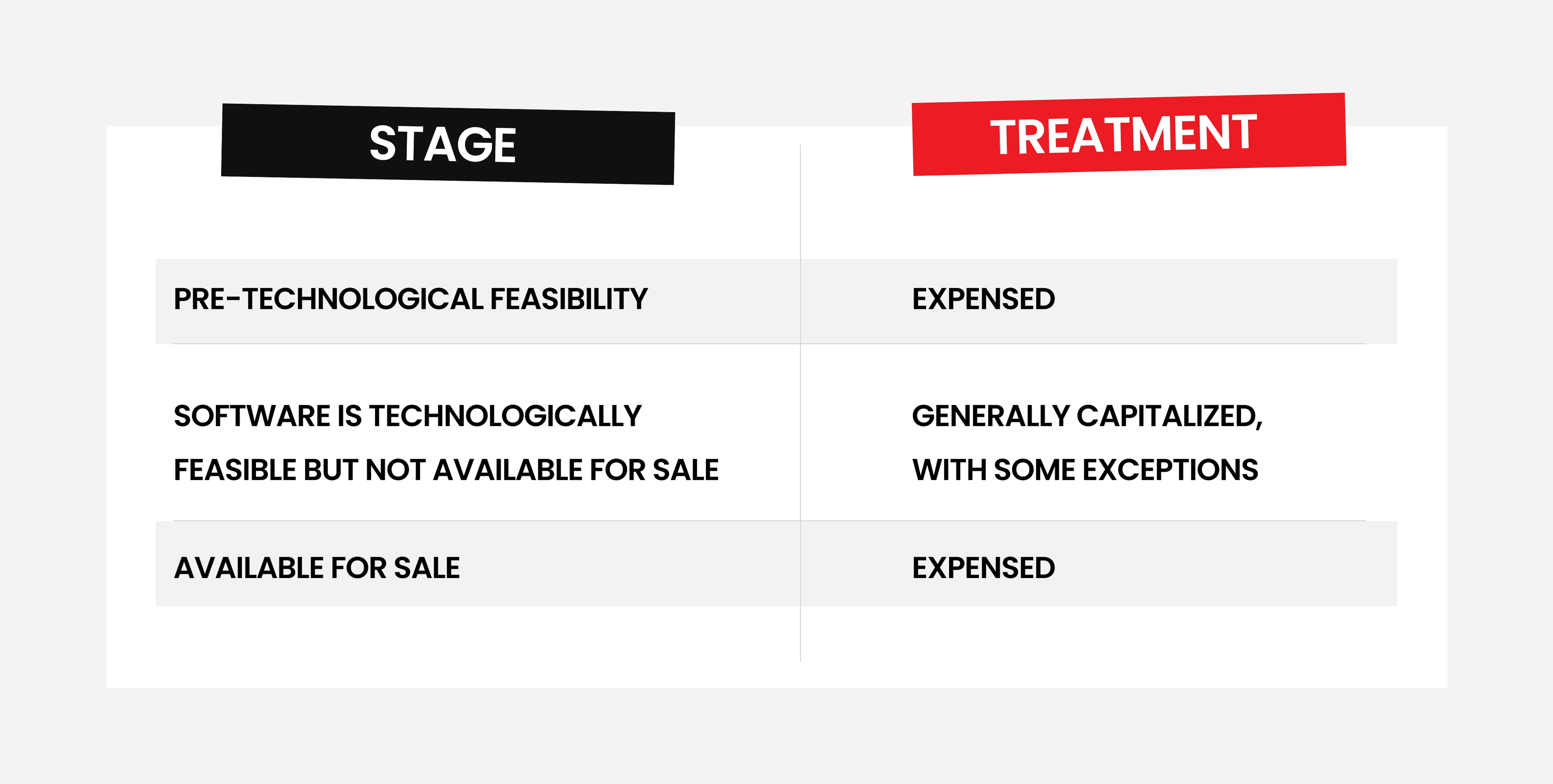
For sell or public use
Software that's sold, leased, or marketed to external users.
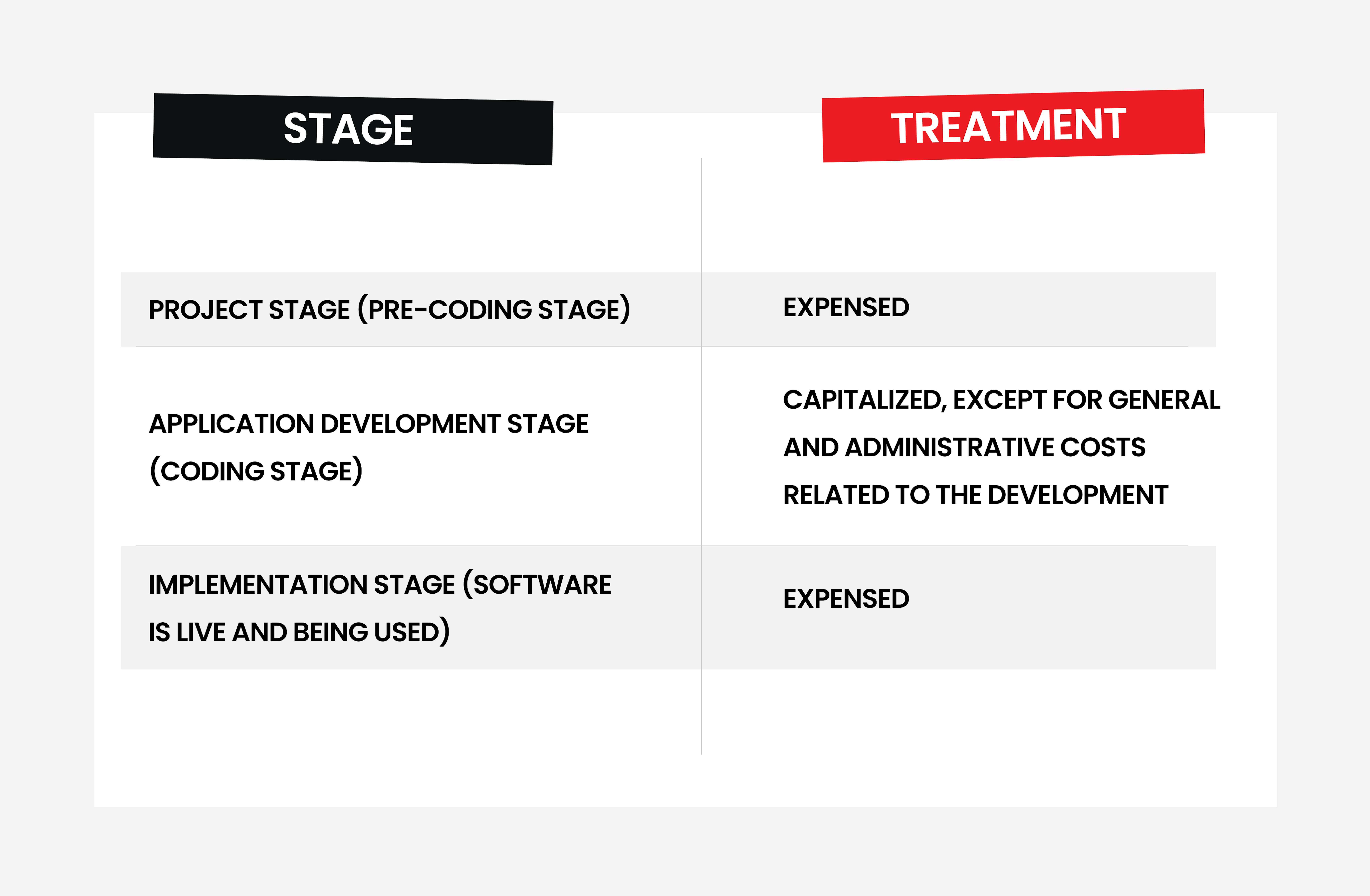
OnTrack wants to sell their app, so they must choose the second option.
Calculating the cost of a software project
OnTrack's example provides a scenario that many companies encounter when outsourcing software development. Here is a list of steps to take to create an estimate for a project before approaching potential vendors:
- Compile a list of tasks and the resources required to complete them - break the project down into smaller, individual tasks, so when you assign them to team members with hourly rates, it'll be easier to calculate how much each of them will cost.
- Identify and allocate resources to tasks based on your team's capacity.
- Estimate the task length to create a project schedule (with some buffer).
- Calculate the project cost based on a chosen estimation method. For example, Ballpark figure, Parameter Estimation.
- Use project cost estimating tools to track budgets in real-time.
Conclusion
The rise of customer-centric tech has forced businesses to develop custom solutions to address their specific needs. Despite the high cost of custom development, many businesses still believe that having a tool that fits their needs makes them stand out. The cost of software development can be hard to understand due to the complexity of the projects involved and the factors that affect the final amount. Having a good estimate, though, helps companies pay a fair price.

